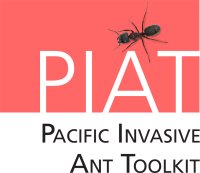At-border
Control at the border involves inspection of incoming goods (including checks of declarations) and passengers and post-entry quarantine.
Border inspection of incoming goods and passengers
| Ideally, all incoming goods including those brought in via a passenger pathway should be inspected by trained biosecurity / quarantine officers in a designated clean area.
However, in situations where the volume of incoming goods is high, it may become necessary for a sub sample from each consignment to be checked. A few resources and tools are required to undertake border inspections (and post-entry quarantine checks). Minimum sampling protocols should be devised to reduce the chances of ants being overlooked. These protocols are usually designed and undertaken by the exporter, and should give the importer 95% confidence that the consignment has been checked and is below the importing country’s specified maximum pest limit (usually 0.5% of a consignment). |

Incoming goods brought in via a passenger pathway should be inspected by trained biosecurity / quarantine officers (© Carolina K Smith MD/shutterstock) |

Biosecurity Amnesty Bins should be installed at each entry point (© PIAT / Kiribati MELAD) |
Biosecurity Amnesty Bins should be installed at each entry point, and well signposted. These bins should be checked after each arrival and the contents checked and disposed of in a way that any risk species / diseases are destroyed.
Any ants detected must be reported immediately and the action advised by the in-country biosecurity team such as fumigation, cleaning, destruction or reshipping should be carried out as soon as possible. Pathways for invasive antsInvasive ants are typically "hitchhikers", travelling long distances secreted in or on cargo moved as part of human mediated trade or travel. These are called pathways. These pathways should be given special attention when inspecting incoming goods. Specific information for each species, based on reported interceptions of the 18 most harmful ant species in the Pacific can be found in this table. |
Known pathways for invasive ants include:
- Sea containers
- Fresh produce (e.g. banana, taro)
- Cut flowers
- Potted plants (extreme high risk in the case of little fire ants)
- Furniture
- Machinery
- Appliances
- Vehicles
- Timber
- Copra shipments
- Personal effects
- Ships in dock, private yachts, cruise ships
- Gravels, sands and soils (these are usually prohibited imports as the risk of invasion is so high)
Known source countries for the worst invasive ants can be found in our invasive ant distribution database.
 |
 |
 |
 |
 |
 |
 |
 |
Risk pathways for invasive ants (© David Wall; Richards Garden Center; Ververidis Vasilis/shutterstock; Mai Thanaprat/shutterstock; Boy_Folio/shutterstock; Valeria Venezia/shutterstock; Carlos Amarillo/shutterstock; Ksander/shutterstock) |
|||
Biosecurity / Quarantine declarations (arrival cards)

Fiji passenger arrival card (click on the image for a larger version) |
Arrival cards are an effective way to ensure that passengers meet biosecurity regulations.
They do rely on people's honesty, and sometimes, unfortunately, this is not certain. So it is important that even though forms have been filled in baggage still needs to be checked (this is particularly important if arrival cards have not been well handled in the past). It is also important to check items if people have declared them. To be effective, the breach of regulations does need to be addressed in some way, if not with a fine, at least with confiscation and a warning. The effective use of arrival cards can greatly increase awareness of the importance of biosecurity. Awareness can also be increased by having posters and other materials available at the border. |
Post-entry quarantine (PEQ)
Import Health Standards or import permits may specify a period of post entry quarantine for high risk items, or items from high risk areas before they are allowed to be released into the importing country. Typically PEQ is used to test for fungal and viral disease or stem burrowing larvae that might not immediately present symptoms in nursery stock and seed imports.
Although in some places regulations assume that detection of invasive ants usually occurs during border inspections, and PeQ is therefore not required, this is perhaps a less cautious approach than desirable. Also, post-border transportation of some commodities is desirable. For example, potted plants, which are host to little fire ants, should be subject to quarantine if they are leaving an area with little fire ants.
This United States Department of Agriculture Imported Fire Ant Program Manual details methods used to implement and enforce quarantine of items that are at high-risk of being infested with red imported fire ants.
Preventative pesticide treatments
- Strategically placed pesticides at high risk sites such as entry points, devanning (container checking) sites and quarantine areas reduces the chances of undetected invasive ant species establishing
- Pesticides may be in the form of liquids in pre-loaded bait stations or paste baits such as Vanquish® Pro. Contact sprays and granular baits may also be used
- The manufacturer of each bait will issue guidelines for optimum bait application rates and these must be followed, particularly closely in high risk areas (e.g. where people may be affected, areas with high conservation values)
- Details about optimum granular bait application and area calculation
- More information on how to use these products can be found in the Getting rid of ants section
Read about an example of how this is done in the Sea Container Hygiene System case study.
content reviewed by Souad Boudjelas, Pacific Invasives Initiative, November 2016
